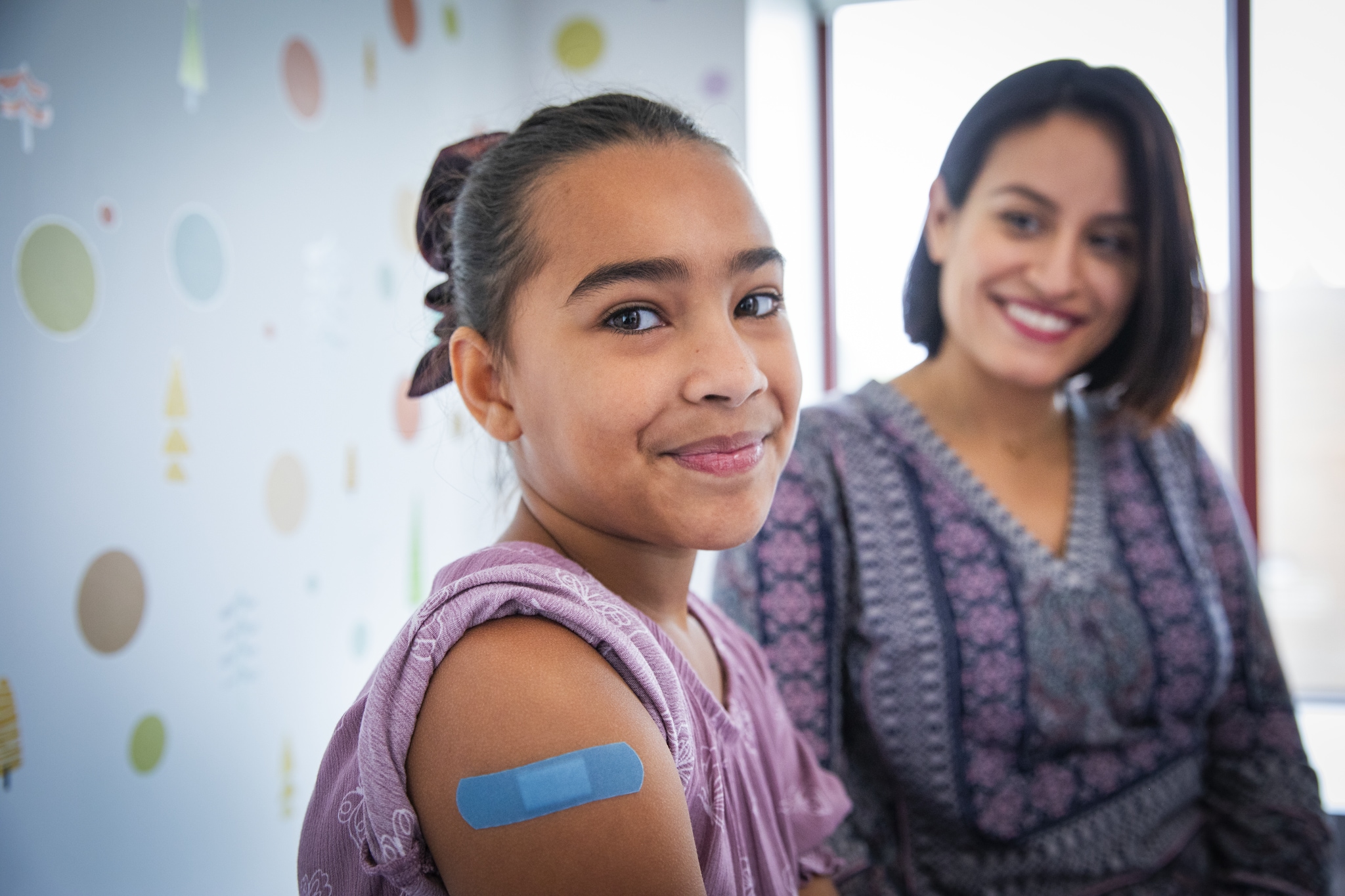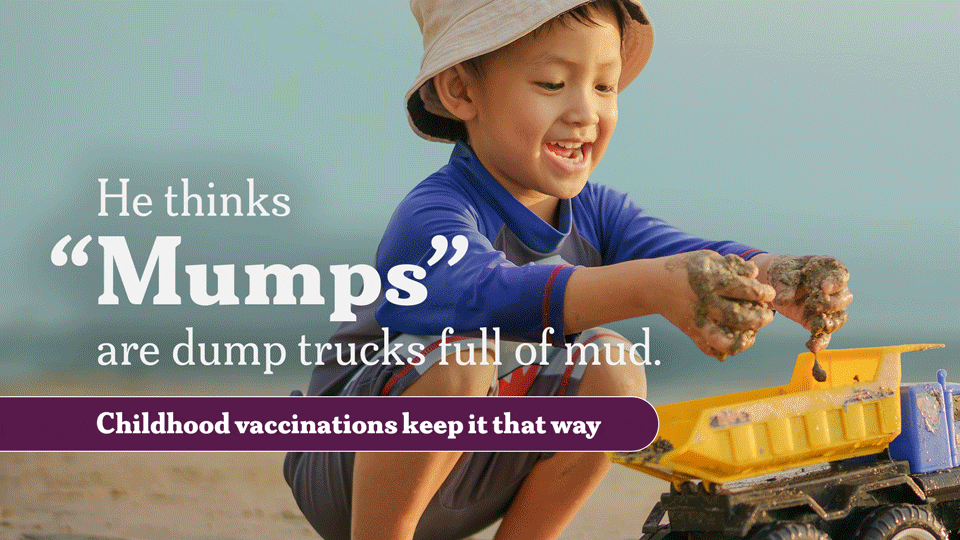What to know
- Childhood vaccination in the U.S. has been very successful in preventing illness and death. Serious diseases such as diphtheria, mumps, and rubella, once common at young ages, are now practically unheard of. Let's keep it that way.
- Keeping up to date with recommended vaccines is one of the best things you can do to help protect your child from serious diseases. Talk to your child's healthcare provider about recommended vaccines.

Overview
On-time immunization plays a vital role in protecting children and communities from serious diseases. The vaccine schedule is developed to offer protection from diseases right on time. It's best to vaccinate a child before being exposed to diseases to reduce the risk of serious disease complications. View the schedules to see which vaccines CDC recommends for each age group and talk to your child's healthcare provider.

Thanks to vaccines, your child has protection against:
Chickenpox
Chickenpox is a contagious viral infection that causes fever, headache, and an itchy, blistering rash; spread through air and direct contact. Can cause infected sores, brain swelling, infection of the lungs (pneumonia), and can be life-threatening, especially in babies, adolescents, adults, pregnant women, and people with weakened immune systems.
One dose at each of the following ages:
- 1st dose: 12-15 months
- 2nd dose: 4-6 years
Older children or adolescents should also get two doses of the chickenpox vaccine if they have never had chickenpox or were never vaccinated. They should also get a second shot if they have had only one chickenpox shot.
COVID-19
COVID-19 is a contagious viral infection of the nose, throat, or lungs; may feel like a cold or flu. Spread through air and direct contact. Can cause infection of the lungs (pneumonia); blood clots; liver, heart, or kidney damage; Long COVID, and can be life-threatening.
CDC recommends an updated COVID-19 vaccine for most adults 18 years and older. Parents of children ages 6 months to 17 years should discuss the benefits of vaccination with a health care provider. Learn more.
Diphtheria
Diphtheria is a contagious bacterial infection of the nose, throat, and sometimes lungs; spread through droplets in the air and direct contact. Can cause thick coating in the back of the nose or throat making it hard to breath and swallow. Can cause heart muscle damage, heart failure, nerve damage, and can be life-threatening.
One dose of DTaP at each of the following ages:
- 1st dose: 2 months
- 2nd dose: 4 months
- 3rd dose: 6 months
- 4th dose: 15-18 months
- 5th dose: 4-6 years
One dose of Tdap at the following ages:
- 1st dose: 11 or 12 years
Flu (Influenza)
Influenza (Flu) is a contagious viral infection of the nose, throat, and sometimes lungs; spread mostly through droplets in the air. Can cause infection of the lungs (pneumonia), sinus and ear infections, worsening of underlying conditions, and can be life-threatening.
Doctors recommend that your child get a flu vaccine every year in the fall, starting when he or she is 6 months old. Some children 6 months through 8 years of age may need 2 doses for best protection.
Hepatitis A
Hepatitis A is a contagious viral infection of the liver; spread by contaminated food or drink or close contact with an infected person. Can cause liver failure and can be life-threatening. Children with the virus often don't have symptoms, but they often pass the disease to others, including unvaccinated parents, caregivers, sibling, or older children. These individuals can get very sick, and symptoms can last up to 6 months.
One dose at each of the following ages:
- 1st dose: 12-23 months
- 2nd dose: 6 months after last dose
Hepatitis B
Hepatitis B is a contagious viral infection of the liver; spread through contact with infected body fluids such as blood or semen. Can cause chronic liver infection, liver failure, liver cancer, and can be life-threatening.
One dose at each of the following ages:
- 1st dose: shortly after birth
- 2nd dose: 1-2 months
- 3rd dose: 6-18 months
Hib (Haemophilus influenza type B)
Hib Disease is a contagious bacterial infection of the lungs, brain and spinal cord, or bloodstream; spread through droplets in the air and direct contact. Depends on the part of the body infected, but can cause brain damage, hearing loss, loss of arm or leg, and can be life-threatening. Babies and children younger than 5 years old are most at risk for Hib disease.
One dose at each of the following ages:
- 1st dose: 2 months
- 2nd dose: 4 months
- 3rd dose: 6 months for some brands
- 4th dose: 12-15 months
HPV (Human Papillomavirus)
HPV (Human papillomavirus) is a contagious viral infection spread through intimate skin-to-skin contact. Can cause genital warts and many types of cancers later in life, including cancers of the cervix, vagina, penis, anus, and throat.
When should my child get the shot?
11-12 Years
- Two doses of the HPV shot are needed, 6-12 months apart.
- If the shots are given less than 5 months apart, a 3rd dose is needed.
If started after 15th birthday
- Three doses of the HPV shot should be given over 6 months.
- If your teen hasn't gotten the vaccine yet, talk to his/her doctor about getting it as soon as possible.
Measles
Measles is a very contagious viral infection that causes high fever, rash, cough, red eyes, and runny nose; spread through air and direct contact. Can cause brain swelling, infection of the lungs (pneumonia), and can be life-threatening especially for young children and babies.
One dose at each of the following ages:
- 1st dose: 12-15 months
- 2nd dose: 4-6 years
Meningococcal
Meningococcal Disease is a contagious bacterial infection of the lining of the brain and spinal cord or the bloodstream; spread through droplets in the air and direct contact. Can cause loss of arm or leg, deafness, seizures, and can be life-threatening.
One dose at each of the following ages:
- 1st dose: 11-12 years
- 2nd dose: 16 years
Mumps
Mumps is a contagious viral infection that causes fever, tiredness, swollen cheeks, and tender swollen jaw; spread through air and direct contact. Can cause brain swelling, painful and swollen testicles or ovaries, deafness, and in rare cases can be life-threatening.
One dose at each of the following ages:
- 1st dose: 12-15 months
- 2nd dose: 4-6 years
Polio
Polio is a contagious viral infection of nerves and brain; spread through the mouth from stool on contaminated hands, food, or liquid, and by air and direct contact. Can cause paralysis and can be life-threatening.
One dose at each of the following ages:
- 1st dose: 2 months
- 2nd dose: 4 months
- 3rd dose: 6-18 months
- 4th dose: 4-6 years
Pneumococcal
Pneumococcal Disease is a bacterial infection of ears, sinuses, lungs, or bloodstream; spread through droplets in the air and direct contact. Depends on the part of the body infected but can cause infection of the lungs (pneumonia), blood poisoning, infection of the lining of the brain and spinal cord, deafness, brain damage, loss of arms or legs, and can be life-threatening.
One dose at each of the following ages:
- 1st dose: 2 months
- 2nd dose: 4 months
- 3rd dose: 6 months
- 4th dose: 12-15 months
Rotavirus
Rotavirus is a contagious viral infection of the gut; spread through the mouth from hands and food contaminated with stool. Can cause severe diarrhea, vomiting, fever, dehydration, and can be life-threatening especially for young children and babies.
Your baby should get either of the two available rotavirus vaccines:
- RotaTeq® (RV5) is given in three doses at ages 2 months, 4 months, and 6 months
- Rotarix® (RV1) is given in two doses at ages 2 months, and 4 months
RSV
Respiratory syncytial virus (RSV) is a contagious viral infection of the nose, throat, and sometimes lungs; spread through direct contact and droplets in the air. Can cause infection of the lungs (pneumonia) and small airways of the lungs, which is especially dangerous for infants and young children.
CDC recommends RSV immunizations during specific months to maximize protection during RSV season. Learn more.
Rubella
Rubella is a contagious viral infection that causes low-grade fever, sore throat, and rash; spread through air and direct contact. Rubella is usually mild in children but is very dangerous for pregnant women; can cause miscarriage or stillbirth, premature delivery, severe birth defects and can be life-threatening.
One dose at each of the following ages:
- 1st dose: 12-15 months
- 2nd dose: 4-6 years
Tetanus
Tetanus (Lockjaw) is a bacterial infection of brain and nerves caused by spores commonly found in soil, dust, and manure; spores enter the body through wounds or broken skin. Can cause seizures, broken bones, difficulty breathing, and can be life-threatening.
One dose of DTAP at each of the following ages:
- 1st dose: 2 months
- 2nd dose: 4 months
- 3rd dose: 6 months
- 4th dose: 15-18 months
- 5th dose: 4-6 years
One dose of Tdap at the following ages:
- 11-12 years
Whooping Cough (Pertussis)
Pertussis (Whooping Cough) is a contagious bacterial infection of the lungs and airway; spread through droplets in the air and direct contact. Can cause infection of the lungs (pneumonia), seizures, brain damage, and can be life-threating especially for babies.
One dose of DTAP at each of the following ages:
- 1st dose: 2 months
- 2nd dose: 4 months
- 3rd dose: 6 months
- 4th dose: 15-18 months
- 5th dose: 4-6 years
One dose of Tdap at the following ages:
- 11-12 years
Free Vaccines for Children
The Vaccines for Children (VFC) program provides vaccines to eligible children at no cost. This program provides free vaccines to children who are Medicaid-eligible, uninsured, underinsured, or American Indian/Alaska Native. Read more on the program's requirements and talk to your child's healthcare provider to see if they are a VFC provider. You can also find a VFC provider by calling your state or local health department or seeing if your state has a VFC website.
